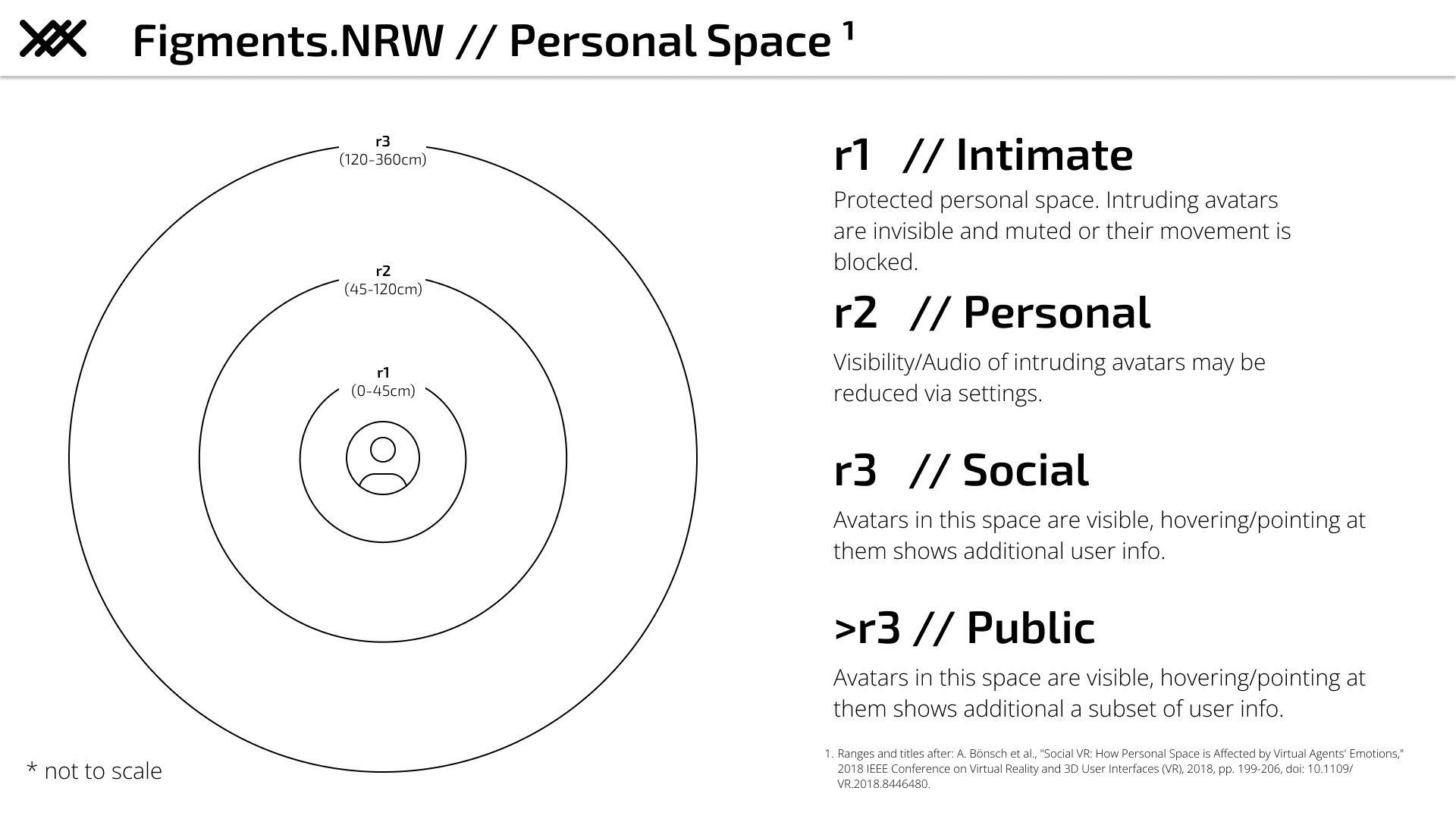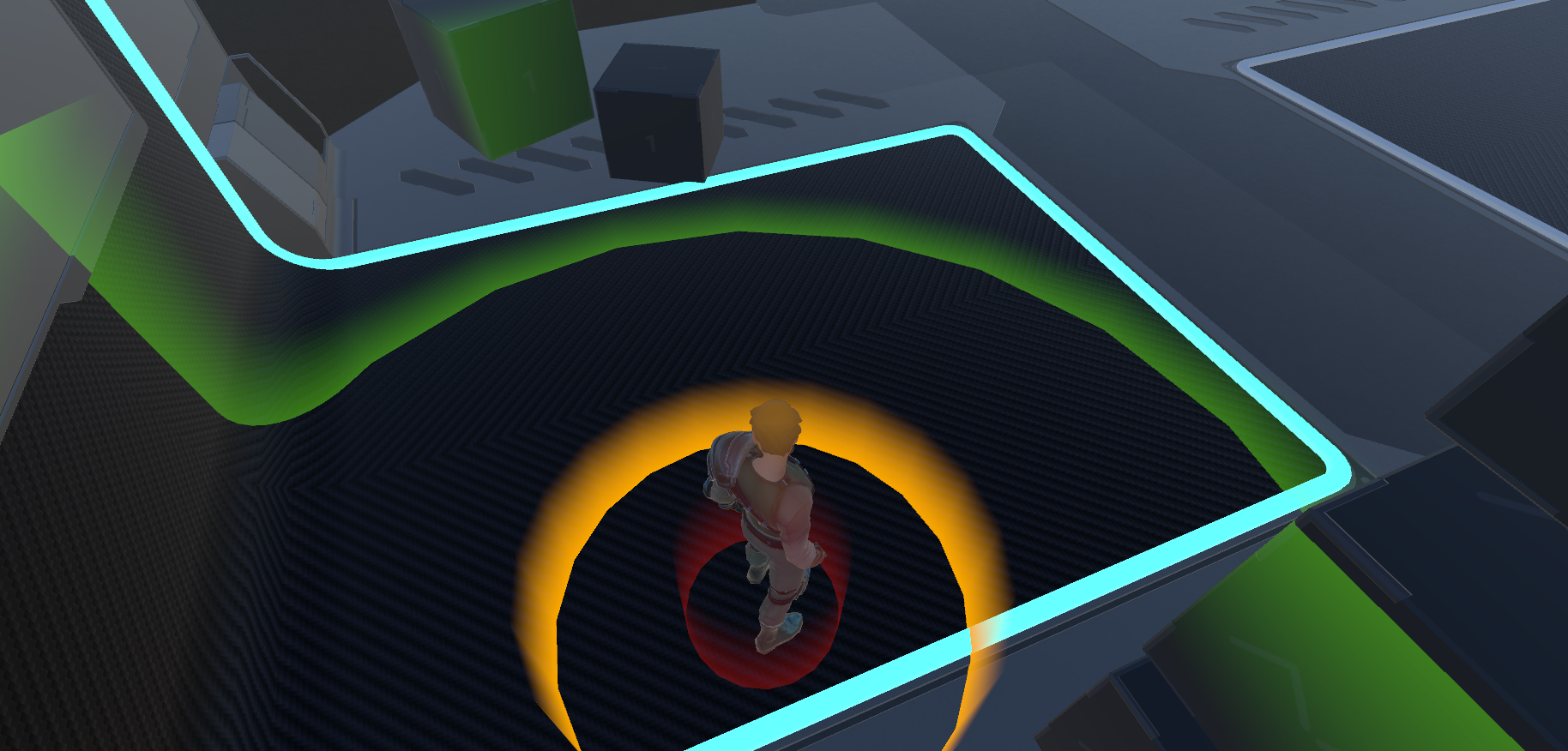Dev #05: Current activities
The team decided on the topic for the second use case, which will be “Content Authoring Pipeline in VR”. With this general topic we want to establish the core concepts and functionalities to create learning content for Virtual Reality directly inside of Virtual Reality – without the need to sidestep between desktop and vr constantly. Focus group for this use case and the evaluation we will be conducting are the content authors, the professors, teachers and assistants. This extends the evaluations of the first study, which focused on the students perspective. A future devblog will showcase our ideas and initial implementations in this regard.
For this devblog we want to talk about our ideas regarding the creation of a safe space for social interactions in Virtual Reality.

The shape and size of personal space
There are a multitude of aspects that involve social interactions, both in the real and in the virtual world. One of these aspects can be described as the interpersonal distance one is comfortable with when interacting with others such as to avoid causing or experiencing discomfort. The general shape of these personal spaces can be evaluated with regards towards the angle others approach oneself, their facial expressions, appearance, general behaviour, gender and if its a group or a single person. In most cases personal space was found to be ellipsoid, nearly circular 2, with a preferred interpersonal distance of around 100cm for interactions. The terms for describing the size of different types of personal spaces used in the literature differ, but mostly describe similar ranges. Bönsch et al. (2018) for example apply ranges first described by Hall (1966) onto applications in Virtual Reality (in their study in a CAVE system). We plan to adapt these ranged to our work on Figments.nrw:
- Intimate Distance (< 45 cm)
This range describes distances with a high probability of physical contact in the real world with a heightend awareness of this for the involved persons. This awareness – and the resulting feeling of uncomfortableness – translates to the virtual world remarkably well, which is why we decided to protect this space. We are conceptualizing ideas to for example block movement of users into this space. - Personal Distance (45-120 cm)
A kind of protective bubble around one’s own person in which others are no longer necessarily perceived as too close or too intrusive, but in which a sense of closeness can still be perceived. The visibility of facial features and body movements of others enables nonverbal influences on one’s interaction (e.g., passing objects) and communication (via spatial voice chat). These can be used in virtual reality in general and in Figments.nrw in particular to enable social interactions that are conducive to learning. The design, animation, and responsiveness of avatars are particularly relevant in this domain.
In the settings, users can turn this protection area on or off. If it is enabled, visibility will be adjusted, as well as the ability to engage in voice chat with users who enter the personal space. We are currently still investigating exactly how we will implement this. We are testing and evaluating various methods, such as reducing visibility or changing the appearance of avatars that approach this area. - Social (120-360cm)
The ability to perceive facial features in detail decreases with increasing distance, in virtual reality even more so than in the real world due to the resolution of most HMDs. In addition, unwanted physical contact is no longer possible at this distance. Social interactions between users who maintain this interpersonal distance are thus often already safer and require fewer to no protective measures. The use of spatial sound for voice chat transfers these aspects well into the virtual space. This is the main area we see for group interactions in virtual reality that do not require special protective measures. - Public (> 360cm)
At this distance, not only are the nuances of an avatar’s appearance and facial expressions reduced, but in most cases, direct interaction between users is something that cannot happen without purposeful intent (which can often be detected early on due to distance). For example, one might get the attention of a more distant user by waving (a highly visible facial expression) or by approaching (an intentional movement).
Since this domain includes all users in a public (virtual) space, we take precautions to reduce possible distractions from others. For example, in the default case, all users will rely on Spatial Audio for communication and therefore will not be audible to others at this distance. At the same time, it is also important to enable group scenarios, instructions and the like, which is why a broadcasting function is planned that allows individual participants to be audible in the entire virtual space.
These considerations about the shape and size of personal space largely relate to interactions between two users or interactions between a user and a small group. Since learning with Figments.nrw will take place in the context of higher education, we also want to support larger group scenarios. How the interpersonal distances mentioned above affect such group scenarios and any necessary adjustments to the sizes and shapes of individuals’ personal spaces in a larger group of similar users (e.g., students) is a possible topic for further study.
Personal space in Figments.nrw

Building on this conceptual foundation, we are currently in the process of implementing Personal Spaces in Figments.nrw. A first draft for our internal development can be seen in the figure above, where the ranges of interpersonal distances are visualized by different colored concentric circles. From this, we will test at what distance we want to enable protections and how they should work. In addition, we will explore ways to use these distance ranges for distance-dependent, situational information provision (e.g., about nearby objects or participants).
Literature
- A. Bönsch et al., “Social VR: How Personal Space is Affected by Virtual Agents’ Emotions,” 2018 IEEE Conference on Virtual Reality and 3D User Interfaces (VR), 2018, pp. 199-206, doi: 10.1109/VR.2018.8446480.
- Hecht, Heiko, et al. “The shape of personal space.” Acta psychologica 193 (2019): 113-122. PDF: https://www.bbk.ac.uk/psychology/bodylab/docs/hechtEtal-acta-2019.pdf, last accessed 2022/03/22
- Alger, Mike. “Visual design methods for virtual reality.” Ravensbourne (2015) PDF: http://aperturesciencellc.com/vr/VisualDesignMethodsforVR_MikeAlger.pdf, last accessed 2022/03/22
- Hall, E. T. “The Hidden Dimension: Man’s Use of Space in Public and Private (London, The Bodley Head).” (1966).



